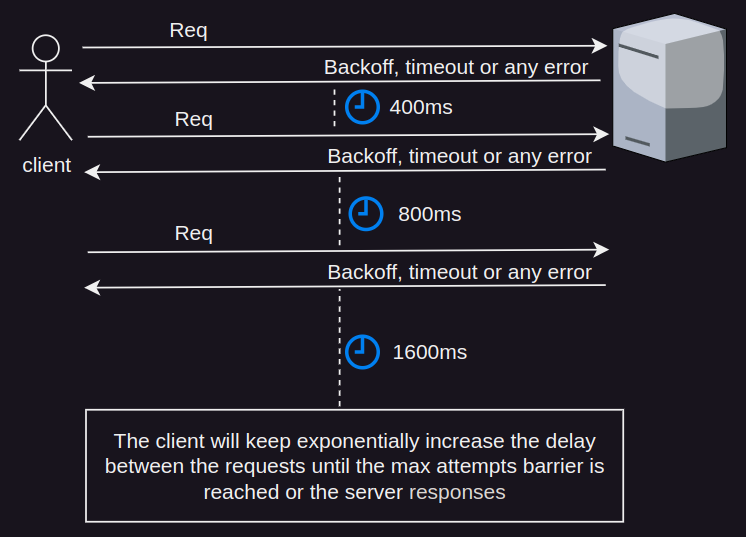Flutter重试策略插件exponential_back_off的使用
Flutter重试策略插件exponential_back_off的使用
重试失败过程,如HTTP请求,使用指数间隔进行每次重试
指数退避算法:
- 指数退避算法通过增加每次重试之间的等待时间来重新尝试请求,直到达到最大退避时间。

特性
- ✅ 启动进程
- ✅ 停止进程
- ✅ 重置进程
- ✅ 设置最大尝试次数
- ✅ 设置最大经过时间
- ✅ 设置最大重试延迟
- ✅ 条件重试
- ✅ 重试回调
- ✅ 调整指数延迟参数
- ✅ 指定延迟的随机性
- ✅ 自定义延迟算法(继承自基类
BackOff)
开始使用
- 将插件添加到你的
pubspec.yaml文件中:
dependencies:
exponential_back_off: ^x.y.z- 在Dart文件中导入
exponential_back_off包:
import 'package:exponential_back_off/exponential_back_off.dart';使用方法
- 创建
ExponentialBackOff对象:
final exponentialBackOff = ExponentialBackOff();- 发起请求:
final result = await exponentialBackOff.start<Response>(
() => http.get(Uri.parse('https://www.gnu.org/')),
);- 处理结果:
你可以通过两种方式处理结果:
- 通过检查结果是否为
isLeft或isRight并相应地获取值。 - 使用
fold函数result.fold((error){},(data){})。fold函数将在结果为错误时调用第一个(Left)函数,否则在结果为数据时调用第二个(Right)函数。
使用if检查:
result.fold(
(error) {
// 左边(Exception):处理错误
print(error);
},
(response) {
// 右边(Response):处理结果
print(response.body);
},
);使用fold:
result.fold(
(error) {
// 左边(Exception):处理错误
print(error);
},
(response) {
// 右边(Response):处理结果
print(response.body);
},
);注意事项
默认配置下,最多将重试10次,第1次、第2次、第3次、…、第9次尝试将休眠(第10次不会休眠)。
随机百分比:>=0.0% <=15%
1. 400 ms +/- (随机百分比的400 ms)
2. 800 ms +/- (随机百分比的800 ms)
3. 1600 ms +/- (随机百分比的1600 ms)
4. 3200 ms +/- (随机百分比的3200 ms)
5. 6400 ms +/- (随机百分比的6400 ms)
6. 12800 ms +/- (随机百分比的12800 ms)
7. 25600 ms +/- (随机百分比的25600 ms)
8. 51200 ms +/- (随机百分比的51200 ms)
9. 102400 ms +/- (随机百分比的102400 ms)
10. 204800 ms +/- (随机百分比的204800 ms) **不会休眠**示例
简单使用案例(默认配置):
final exponentialBackOff = ExponentialBackOff();
/// 结果类型为 [Either<Exception, Response>]
final result = await exponentialBackOff.start<Response>(
// 发起请求
() {
return get(Uri.parse('https://www.gnu.org/'))
.timeout(Duration(seconds: 10));
},
// 在SocketException或TimeoutException发生时重试,其他情况则停止并返回错误
retryIf: (e) => e is SocketException || e is TimeoutException,
);
/// 你可以通过两种方式处理结果
/// * 通过检查结果 `isLeft` 或 `isRight` 并相应地获取值。
/// * 使用 `fold` 函数 `result.fold((error){},(data){})`。如果结果是错误,将调用第一个(Left)函数;如果是数据,则调用第二个(Right)函数。
///
/// 错误将始终在 `Left` 中,数据将始终在 `Right` 中
// 使用if检查
if (result.isLeft()) {
// 左边(Exception):处理错误
final error = result.getLeftValue();
print(error);
} else {
// 右边(Response):处理结果
final response = result.getRightValue();
print(response.body);
}
// 使用fold
result.fold(
(error) {
// 左边(Exception):处理错误
print(error);
},
(response) {
// 右边(Response):处理结果
print(response.body);
},
);重用同一个对象(默认配置):
// 重置将调用stop()并将所有内容重置为零
await exponentialBackOff.reset();
print('间隔: ' + exponentialBackOff.interval.toString());
print('最大随机化因子: ' + exponentialBackOff.maxRandomizationFactor.toString());
print('最大尝试次数: ' + exponentialBackOff.maxAttempts.toString());
print('最大延迟: ' + exponentialBackOff.maxDelay.toString());
print('最大经过时间: ' + exponentialBackOff.maxElapsedTime.toString());
print('==================================================================');
await exponentialBackOff.start(
() => get(Uri.parse('https://www.gnu.org/')).timeout(
Duration.zero, // 将始终抛出TimeoutException
),
retryIf: (e) => e is SocketException || e is TimeoutException,
onRetry: (error) {
print('尝试: ' + exponentialBackOff.attemptCounter.toString());
print('错误: ' + error.toString());
print('当前延迟: ' + exponentialBackOff.currentDelay.toString());
print('经过时间: ' + exponentialBackOff.elapsedTime.toString());
print('--------------------------------------------------------');
},
);调整指数延迟参数:
// 最多重试5次,
// 第1次、第2次、第3次、第4次尝试将休眠(第5次不会休眠)
//
// 随机百分比:0.0%
//
// 1. 200 ms
// 2. 400 ms
// 3. 800 ms
// 4. 1600 ms
// 5. 3200 ms **不会休眠**
final exponentialBackOff = ExponentialBackOff(
interval: Duration(milliseconds: 100),
maxAttempts: 5,
maxRandomizationFactor: 0.0,
maxDelay: Duration(seconds: 15),
);
print('间隔: ' + exponentialBackOff.interval.toString());
print('最大随机化因子: ' + exponentialBackOff.maxRandomizationFactor.toString());
print('最大尝试次数: ' + exponentialBackOff.maxAttempts.toString());
print('最大延迟: ' + exponentialBackOff.maxDelay.toString());
print('最大经过时间: ' + exponentialBackOff.maxElapsedTime.toString());
print('==================================================================');
await exponentialBackOff.start(
() => get(Uri.parse('https://www.gnu.org/')).timeout(
Duration.zero, // 将始终抛出TimeoutException
),
retryIf: (e) => e is SocketException || e is TimeoutException,
onRetry: (error) {
print('尝试: ' + exponentialBackOff.attemptCounter.toString());
print('错误: ' + error.toString());
print('当前延迟: ' + exponentialBackOff.currentDelay.toString());
print('经过时间: ' + exponentialBackOff.elapsedTime.toString());
print('--------------------------------------------------------');
},
);自定义延迟
- 创建一个从
Backoff基类继承的子类
/// 线性延迟:
///
/// 1. 1000 ms
/// 2. 2000 ms
/// 3. 3000 ms
/// 4. 4000 ms
/// 5. 5000 ms
class CustomDelay extends BackOff {
CustomDelay({
super.maxAttempts,
super.maxDelay,
super.maxElapsedTime,
}) : assert(maxAttempts != null || maxElapsedTime != null,
'不能同时为maxAttempts和maxElapsedTime设置null');
@override
Duration computeDelay(int attempt, Duration elapsedTime) {
return Duration(seconds: attempt);
}
}
- 如常使用它
// 最多重试5次,
// 第1次、第2次、第3次、第4次尝试将休眠(第5次不会休眠)
//
// 1. 1000 ms
// 2. 2000 ms
// 3. 3000 ms
// 4. 4000 ms
// 5. 5000 ms **不会休眠**
final customDelay = CustomDelay(maxAttempts: 5);
print('最大尝试次数: ' + customDelay.maxAttempts.toString());
print('最大延迟: ' + customDelay.maxDelay.toString());
print('最大经过时间: ' + customDelay.maxElapsedTime.toString());
print('==================================================================');
await customDelay.start(
() => get(Uri.parse('https://www.gnu.org/')).timeout(
Duration.zero, // 将始终抛出TimeoutException
),
retryIf: (e) => e is SocketException || e is TimeoutException,
onRetry: (error) {
print('尝试: ' + customDelay.attemptCounter.toString());
print('错误: ' + error.toString());
print('当前延迟: ' + customDelay.currentDelay.toString());
print('经过时间: ' + customDelay.elapsedTime.toString());
print('--------------------------------------------------------');
},
);更多关于Flutter重试策略插件exponential_back_off的使用的实战系列教程也可以访问 https://www.itying.com/category-92-b0.html
1 回复
更多关于Flutter重试策略插件exponential_back_off的使用的实战系列教程也可以访问 https://www.itying.com/category-92-b0.html
当然,exponential_back_off 是一个在 Flutter 中常用的重试策略插件,它基于指数退避算法,可以在网络请求失败时自动进行重试,并且每次重试之间的间隔时间会逐渐增加。以下是如何在 Flutter 项目中使用 exponential_back_off 插件的一个简单示例。
首先,你需要在你的 pubspec.yaml 文件中添加 exponential_back_off 依赖:
dependencies:
flutter:
sdk: flutter
exponential_back_off: ^x.y.z # 请使用最新版本号替换 x.y.z然后运行 flutter pub get 来获取依赖。
接下来是一个使用 exponential_back_off 插件进行网络请求并应用重试策略的示例代码:
import 'package:flutter/material.dart';
import 'package:dio/dio.dart';
import 'package:exponential_back_off/exponential_back_off.dart';
void main() {
runApp(MyApp());
}
class MyApp extends StatelessWidget {
@override
Widget build(BuildContext context) {
return MaterialApp(
home: Scaffold(
appBar: AppBar(
title: Text('Exponential Back-off Example'),
),
body: Center(
child: RetryButton(),
),
),
);
}
}
class RetryButton extends StatefulWidget {
@override
_RetryButtonState createState() => _RetryButtonState();
}
class _RetryButtonState extends State<RetryButton> {
String responseText = '';
void makeRequest() async {
final dio = Dio();
final backOff = ExponentialBackOff()
..initialInterval = Duration(seconds: 1) // 初始间隔时间
..maxInterval = Duration(seconds: 10) // 最大间隔时间
..maxElapsedTime = Duration(minutes: 1); // 最大总重试时间
bool success = await backOff.retry(
() async {
try {
Response response = await dio.get('https://api.example.com/data');
setState(() {
responseText = response.data.toString();
});
return true; // 返回 true 表示成功
} catch (e) {
print('Request failed: $e');
return false; // 返回 false 表示失败,将触发重试
}
},
onRetry: (attempt) {
print('Retry attempt $attempt');
},
onCompletion: () {
print('Completed all retry attempts');
},
);
if (!success) {
setState(() {
responseText = 'Failed to fetch data after multiple attempts.';
});
}
}
@override
Widget build(BuildContext context) {
return Column(
mainAxisAlignment: MainAxisAlignment.center,
children: <Widget>[
Text(responseText),
SizedBox(height: 20),
ElevatedButton(
onPressed: makeRequest,
child: Text('Fetch Data'),
),
],
);
}
}在这个示例中:
- 我们使用
dio库来进行网络请求。 ExponentialBackOff被配置了一个初始间隔时间、最大间隔时间和最大总重试时间。retry方法用于执行带有重试逻辑的网络请求。如果请求失败(即catch块被触发),它会返回false并触发重试。onRetry回调会在每次重试时打印当前的重试次数。onCompletion回调会在所有重试尝试完成后执行,无论成功还是失败。
这样,你就可以在 Flutter 项目中使用 exponential_back_off 插件来实现带有指数退避算法的重试策略了。








